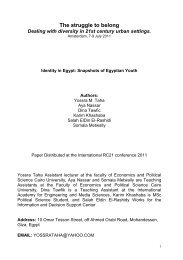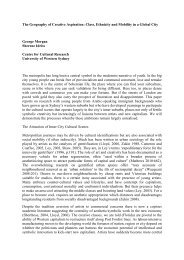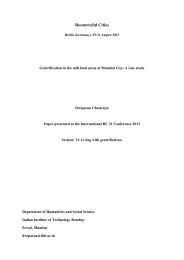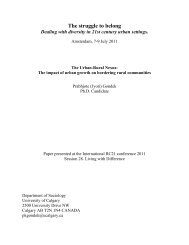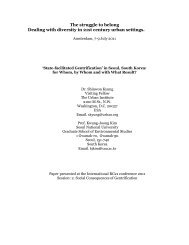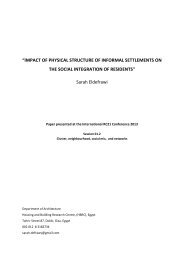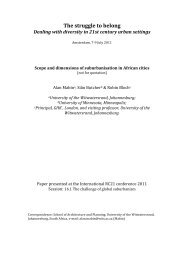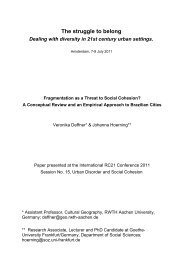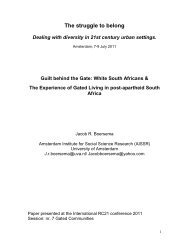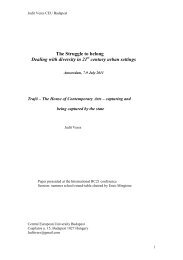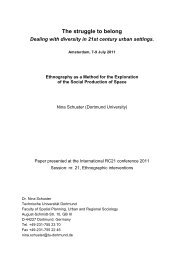The hidden side of metropolization. Governing squats and slums in ...
The hidden side of metropolization. Governing squats and slums in ...
The hidden side of metropolization. Governing squats and slums in ...
You also want an ePaper? Increase the reach of your titles
YUMPU automatically turns print PDFs into web optimized ePapers that Google loves.
22<br />
evaluation <strong>of</strong> the project is not so positive after 5 years. In April 2011, 59 people were still liv<strong>in</strong>g <strong>in</strong><br />
the village. 2 <strong>in</strong>habitants got a stable job, 7 an unstable job. 4 families are <strong>in</strong>volved <strong>in</strong>to a<br />
pr<strong>of</strong>essional tra<strong>in</strong><strong>in</strong>g. S<strong>in</strong>ce July 2010 two families have been relocated <strong>in</strong> a stable house 23 . <strong>The</strong><br />
managers <strong>of</strong> the project argue that “it is better than noth<strong>in</strong>g”.<br />
<strong>The</strong> “village” <strong>in</strong>strument enables local authorities to control l<strong>and</strong>s <strong>and</strong> populations. <strong>The</strong> urban project<br />
frame actors <strong>and</strong> public authorities are able to govern their behavior (Foucault) as well as they can<br />
reclaim l<strong>and</strong>. Beyond the political will<strong>in</strong>gness to provide welfare to poor people, this project could<br />
be <strong>in</strong>terpreted follow<strong>in</strong>g two hypotheses. <strong>The</strong> first is a blame avoidance strategy (Weaver, 1986):<br />
local <strong>of</strong>ficials want to legitimate the eviction <strong>of</strong> a slum <strong>and</strong> to avoid the blame from voters who<br />
usually protest aga<strong>in</strong>st such practices. <strong>The</strong> second is a discipl<strong>in</strong>e strategy: <strong>in</strong> order to keep control on<br />
the territory with technical dispositive, local actors build statistics <strong>and</strong> provide m<strong>in</strong>imum social<br />
services. We observed a differential government <strong>of</strong> illegalisms aga<strong>in</strong> <strong>in</strong> the sense that the selection<br />
process categorizes differently the same populations <strong>and</strong> normalizes some <strong>of</strong> them <strong>in</strong> order to evict<br />
the former.<br />
Conclusion<br />
To give a general perspective <strong>of</strong> the urban governance around <strong>squats</strong> <strong>and</strong> <strong>slums</strong> we could say that the<br />
State (National Government) evicts the illegal settlements <strong>and</strong> <strong>squats</strong> <strong>and</strong> also give funds to realize<br />
local projects. However, we do not observe a real public policy towards <strong>squats</strong> <strong>and</strong> <strong>slums</strong><br />
implemented at the national scale. <strong>The</strong> local level seems more relevant <strong>in</strong> that field. I showed that<br />
many <strong>in</strong>itiatives com<strong>in</strong>g from the municipalities push <strong>of</strong>ficials <strong>and</strong> decision makers to implement<br />
specific urban policies <strong>and</strong> tools <strong>in</strong> order to normalize <strong>and</strong> control illegal occupations.<br />
<strong>The</strong> project <strong>and</strong> the contract are used as urban planners’ <strong>in</strong>struments <strong>in</strong> order to build a more<br />
susta<strong>in</strong>able city on a short-life place like <strong>squats</strong> or <strong>slums</strong>. On the one h<strong>and</strong>, squatt<strong>in</strong>g is limited <strong>in</strong><br />
time <strong>and</strong> eviction is unavoidable. On the other h<strong>and</strong>, the ma<strong>in</strong> claim for policy makers is to build a<br />
susta<strong>in</strong>able city. Squatt<strong>in</strong>g seems to be a relevant transition between these two dimensions <strong>and</strong> the<br />
project could be the procedural l<strong>in</strong>k. <strong>The</strong> city council is <strong>in</strong> charge <strong>of</strong> controll<strong>in</strong>g its territory but is not<br />
able to make use <strong>of</strong> all available spaces: vacant spaces persist <strong>in</strong> Ile-de-France (for <strong>in</strong>stance, some as<br />
<strong>in</strong>dustrial waste l<strong>and</strong>). <strong>The</strong> project <strong>and</strong> the precarious contracts are means to struggle aga<strong>in</strong>st these<br />
vacant spaces by occupy<strong>in</strong>g them while wait<strong>in</strong>g for a more susta<strong>in</strong>able project. Above all, these<br />
<strong>in</strong>struments are powerful tools <strong>of</strong> control over the population <strong>and</strong> l<strong>and</strong>s. <strong>The</strong> ungovernable city<br />
becomes governable at certa<strong>in</strong> moments, for certa<strong>in</strong> populations <strong>and</strong> certa<strong>in</strong> l<strong>and</strong>s. Moreover,<br />
govern<strong>in</strong>g <strong>squats</strong> <strong>and</strong> <strong>slums</strong> aims at build<strong>in</strong>g public order <strong>in</strong> the city. Public order is built with four<br />
ma<strong>in</strong> vectors. <strong>The</strong> first is the ownership right: the Law has to enforce it. <strong>The</strong> second vector is the<br />
public health <strong>and</strong> security. Many problems emerged <strong>in</strong> these places <strong>and</strong> public actors have to provide<br />
welfare to the <strong>in</strong>habitants. <strong>The</strong> third is the project. <strong>Govern<strong>in</strong>g</strong> a society or a city consists <strong>in</strong><br />
develop<strong>in</strong>g project <strong>and</strong> build<strong>in</strong>g strategies to attract <strong>in</strong>vestments <strong>and</strong> <strong>in</strong>crease the economic growth,<br />
to limit the urban expansion <strong>and</strong> build a susta<strong>in</strong>able city. Furthermore, it <strong>in</strong>volves the provision <strong>of</strong><br />
services <strong>and</strong> <strong>in</strong>frastructures for citizens. <strong>The</strong> fourth is the “nuisance”. Nobody can disturb the<br />
“normal” life <strong>of</strong> the city.<br />
As Pierre Favre suggested, “the Government governs, <strong>of</strong> course, but it does not govern everybody<br />
<strong>and</strong> all the time (…) the Governor governs only certa<strong>in</strong> sectors <strong>of</strong> society <strong>and</strong> at certa<strong>in</strong> times”<br />
(Favre, 2003). Thus, municipalities try to decrease the ungovernable <strong>in</strong>terstices <strong>and</strong> to <strong>in</strong>crease their<br />
political capacities by enlarg<strong>in</strong>g the territories that are normalized, framed by rules <strong>and</strong> on which an<br />
urban project assures the build<strong>in</strong>g <strong>of</strong> a susta<strong>in</strong>able metropolis. I propose to explore the urban<br />
governance by the bottom, by the negative. Underst<strong>and</strong><strong>in</strong>g the government <strong>of</strong> the “marg<strong>in</strong>” <strong>and</strong> the<br />
23 ALJ 93, Avril 2011. Bilan MOUS Aubervilliers.




